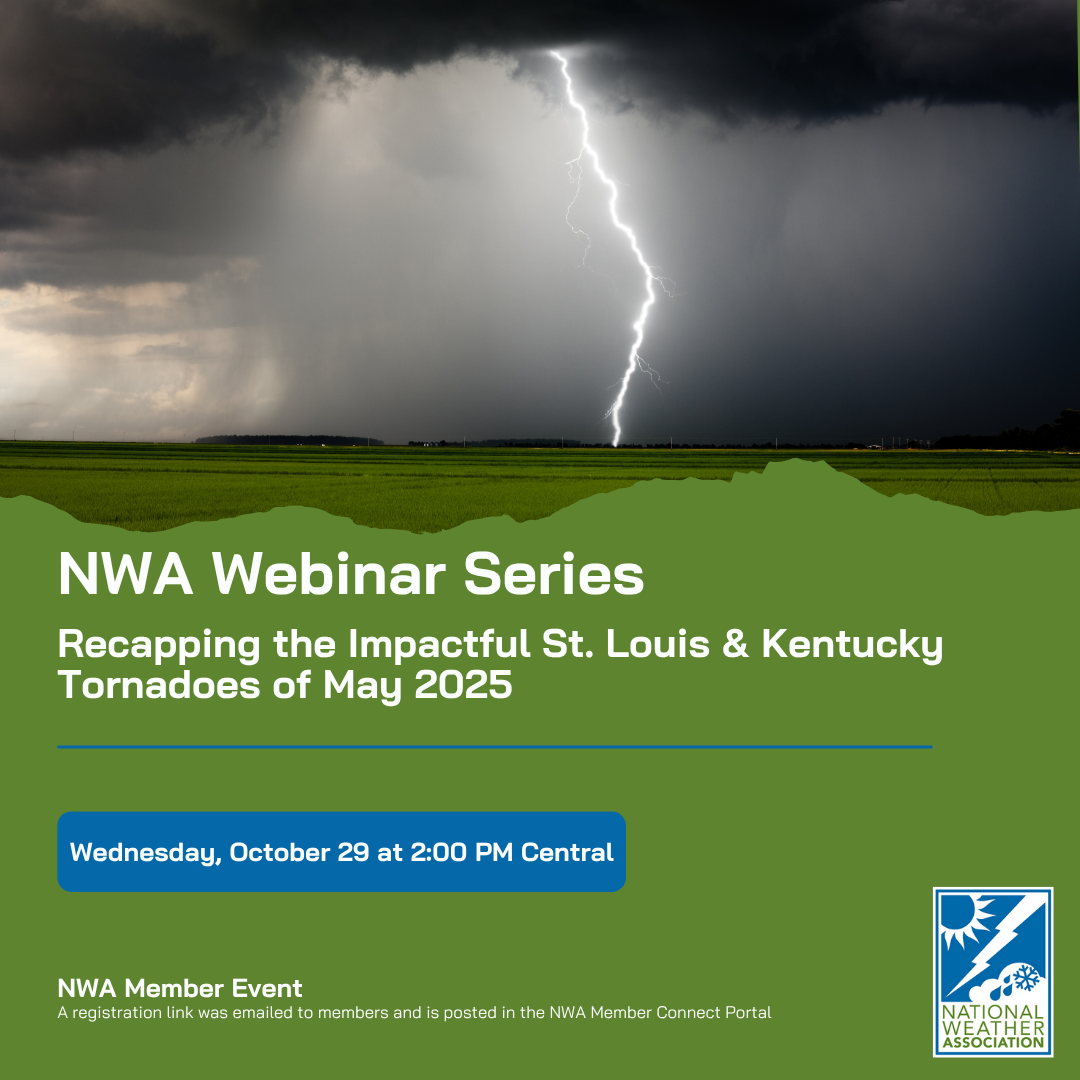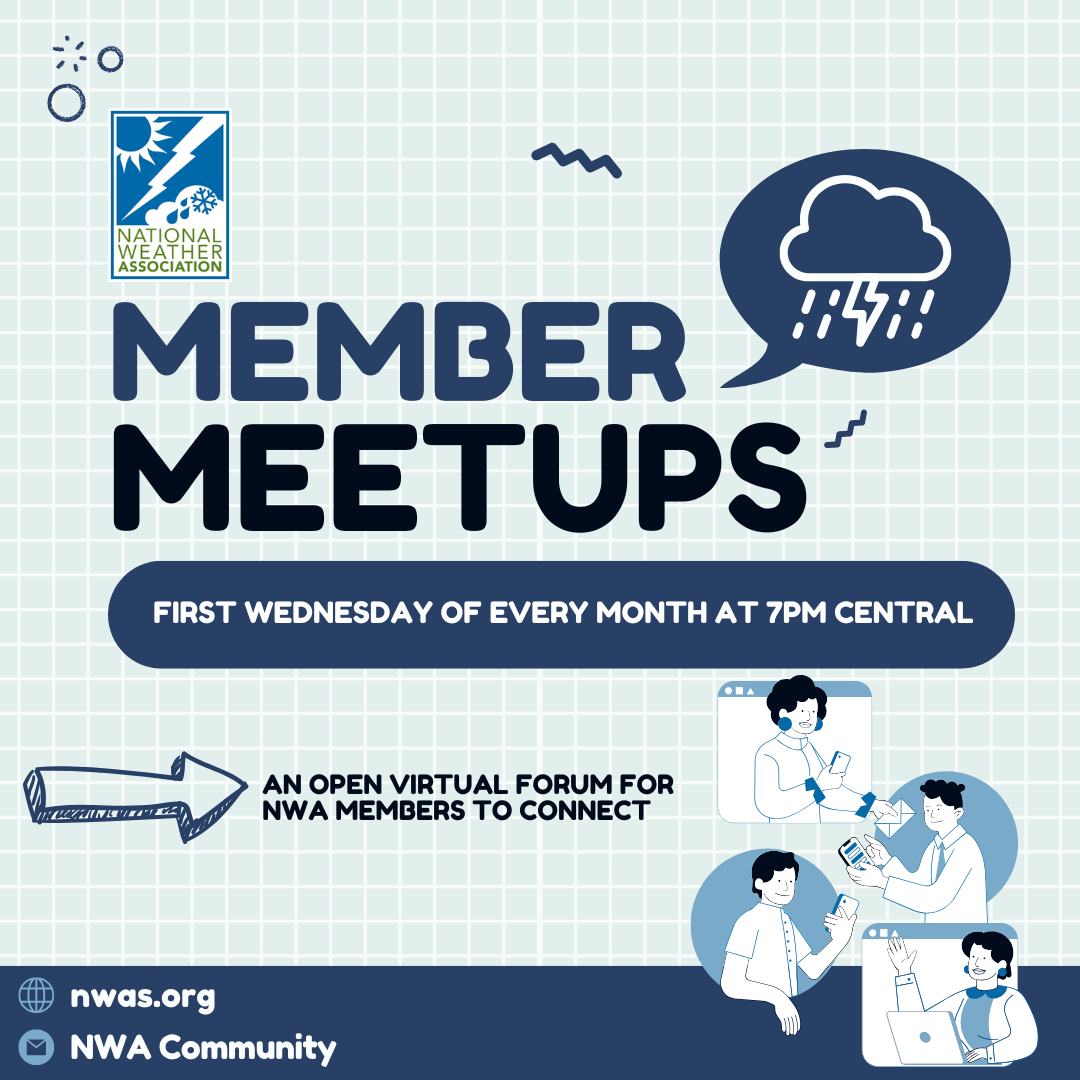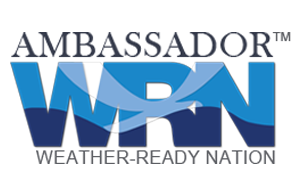|
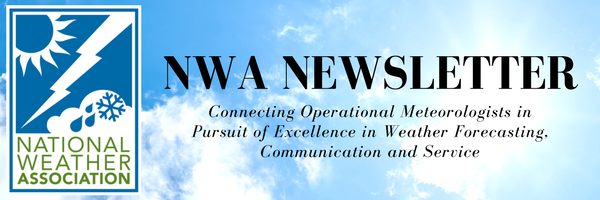
NWA April 2018 Newsletter
Issue 18-4
What's in this newsletter...
Important Dates
National Tropical Weather Conference
April 3-7, 2018
NWA Foundation Spring Scholarships Applications
Due April 5
NWA April Webinar
Wednesday April 11 at 11am CDT
NWA Foundation Spring Grant Applications
Due May 3
NWA Awards Submissions
Due Thursday May 17
NWAF WeatherReady Fest
Saturday August 25
NWA Annual Meeting
August 25-30
A High Pressure Storm
Alan Sealls - NWA President 2018 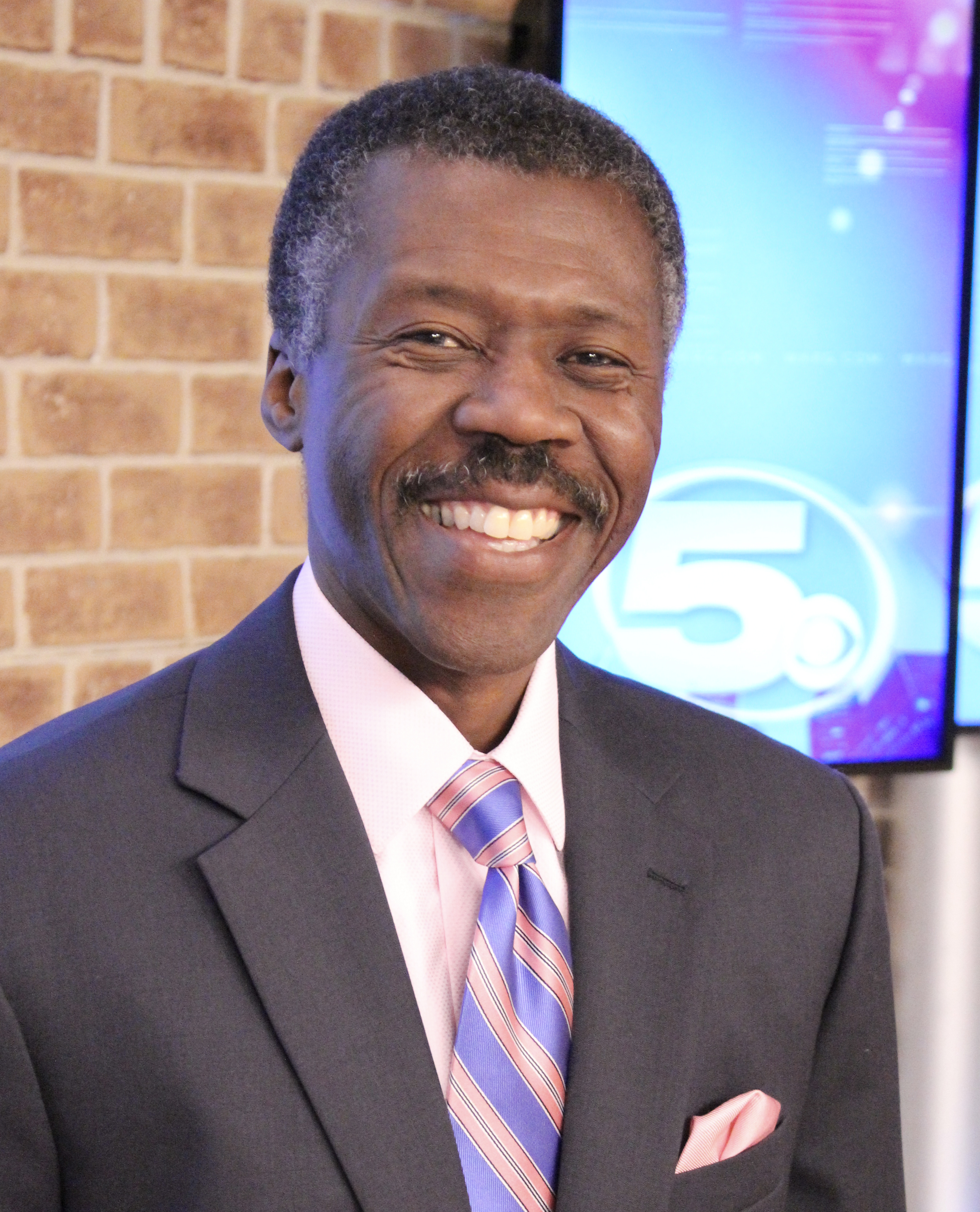 From winter storms to severe storms and hurricanes, we in the weather enterprise track tempests traversing the landscape. The prospect of a powerful low pressure system brings high pressure to our lives. That pressure can create anxiety and stress, with stress being both mental and physical. At work, have you been told to do less? Ha ha, I know the answer! Let’s laugh together at that as laughter is a good stress-reliever. Do you want to laugh some more? Have you been given shorter work hours and a raise? Okay, stop laughing. It seems that all of us work harder and juggle more tasks than ever. For a meteorologist, just creating an accurate and precise forecast or assessment on schedule can be stressful. Big weather events are even more worrisome. We are under high pressure to perform. It may be long hours and many days of preparation and/or recovery. Storm impact can be costly, tragic, and deadly. If disaster follows, how might you handle it? Surely, you’d ask yourself if you did everything possible in communicating the threat, uncertainty, and possibility of disaster. After an immediate crisis, it wouldn't be unusual to experience sadness, guilt, and even depression to some degree. Combine those with the stressors from your daily workload, feeling overworked or underpaid, or working in an unhappy environment may leave you feeling like you need help. Those stresses, even without a disaster, can grow to critical levels. I've seen co-workers have breakdowns. I know of alcohol and substance dependency by good people. Stress and depression carryover from home life to job life and vice versa. They may lead to, or be related to, substance abuse. We all have probably heard news reports of professionals who have committed suicide. While those may not be totally due to workplace stress or depression, our jobs certainly influence our overall state of mind. To be the best we can be as weather experts, we must be aware of our psychological well-being. I’m not a mental health expert but I offer these simple tips for handling the high pressure of our profession.
- Wherever possible, limit stress. Avoid certain people at work or in your life who tend to have a cloud of drama over them. Yes, I know that is sometimes impossible.
- Maintain a regular fitness routine, which includes sufficient sleep and a healthy diet.
- Put time into a hobby or interest that has nothing to do with weather so you can let your mind relax.
- Whether you call it prayer, meditation, or just good vibes, stay strong spiritually.
- Cliché alert: Stop and smell the roses. Focus on the good things and good people around you that you might take for granted.
- Prepare professionally with knowledge and training. You will be more confident and less-stressed in most weather scenarios when you know patterns and possible outcomes. The NWA has meetings, webinars, and good networking with colleagues who can share insight into how they handle both extreme events, and the workplace environment.
- If you feel overwhelmed, reach out to friends and family; speak with your supervisor or human resources person; and if necessary, speak to a professional.
- Take advantage of counseling and mental health services offered by your company or agency.
We all have different tolerances for stress and anxiety, and different methods for handling them. If you are approaching your limit, don’t ignore it—address it. Be well.
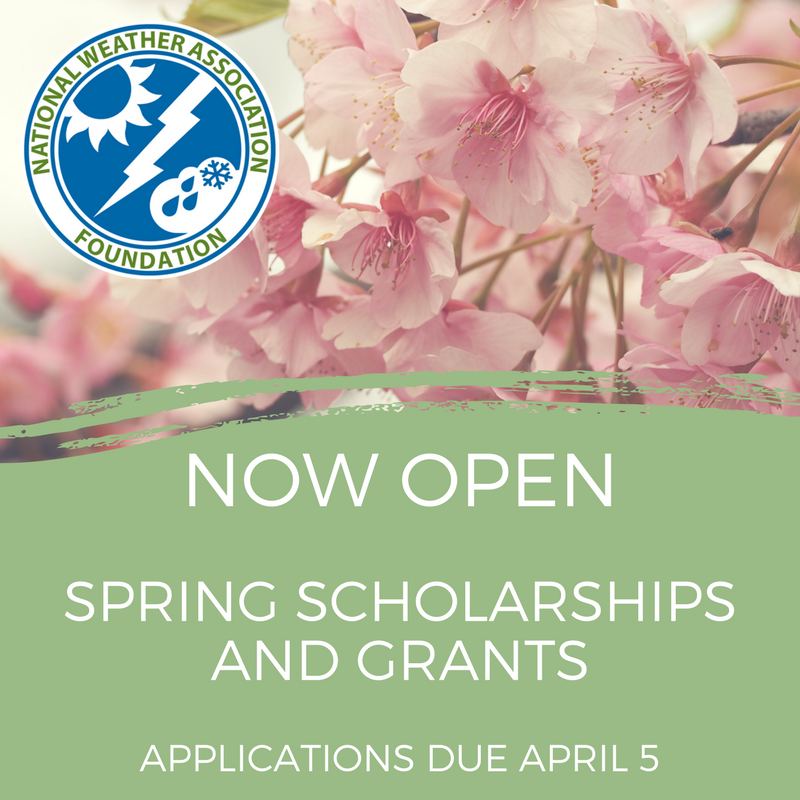
Three More Seals Awarded
Congratulations are in order for three more broadcasters who can add “NWA Seal Holder” to their resume!
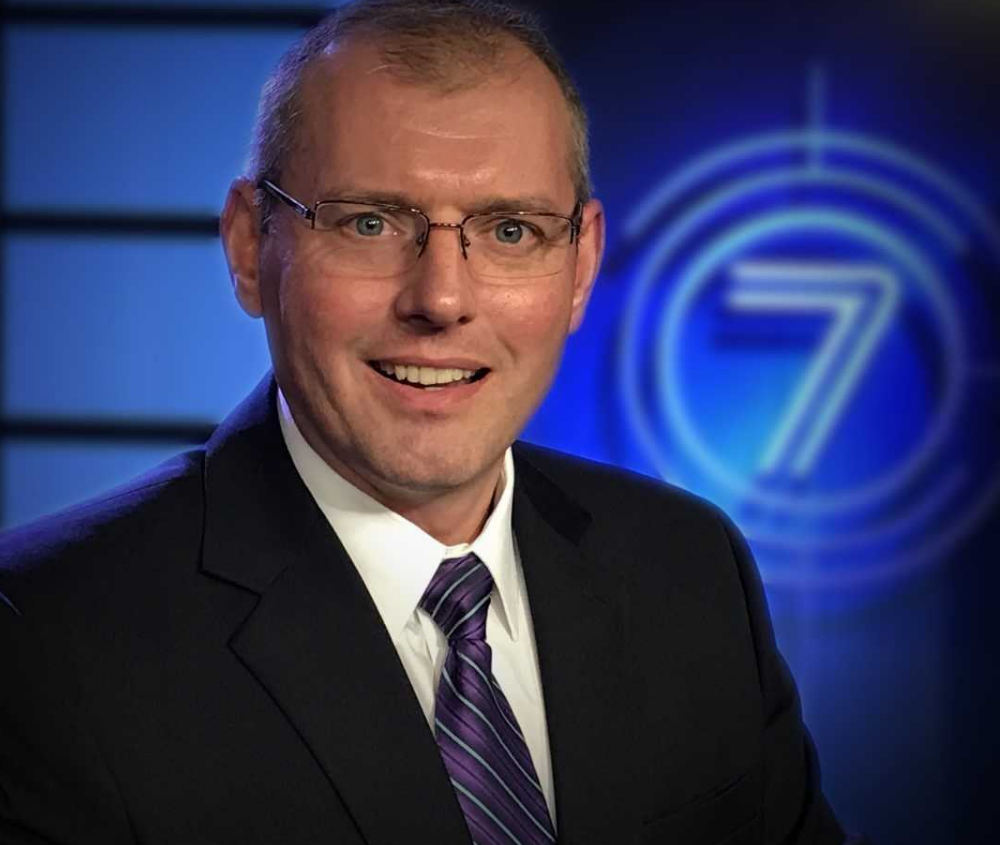 First is John Kubis from WWNY Watertown, New York. John first started reporting weather for the Air Force. In 2009, he began doing the weather for WWNY on the weekends. He has since been promoted to evenings as Chief Weathercaster. John said he’s thrilled to receive the NWA Seal. He told us he used to chase tornadoes at Tinker Air Force Base in Oklahoma “before there was internet or RadarScope.” First is John Kubis from WWNY Watertown, New York. John first started reporting weather for the Air Force. In 2009, he began doing the weather for WWNY on the weekends. He has since been promoted to evenings as Chief Weathercaster. John said he’s thrilled to receive the NWA Seal. He told us he used to chase tornadoes at Tinker Air Force Base in Oklahoma “before there was internet or RadarScope.”
“My favorite season to cover weather is our summer severe thunderstorm season in upstate New York,” said John. His favorite cloud is the good old reliable fair weather cumulus. He says if he weren't a weather forecaster, he would like to be an electrician or a welder.
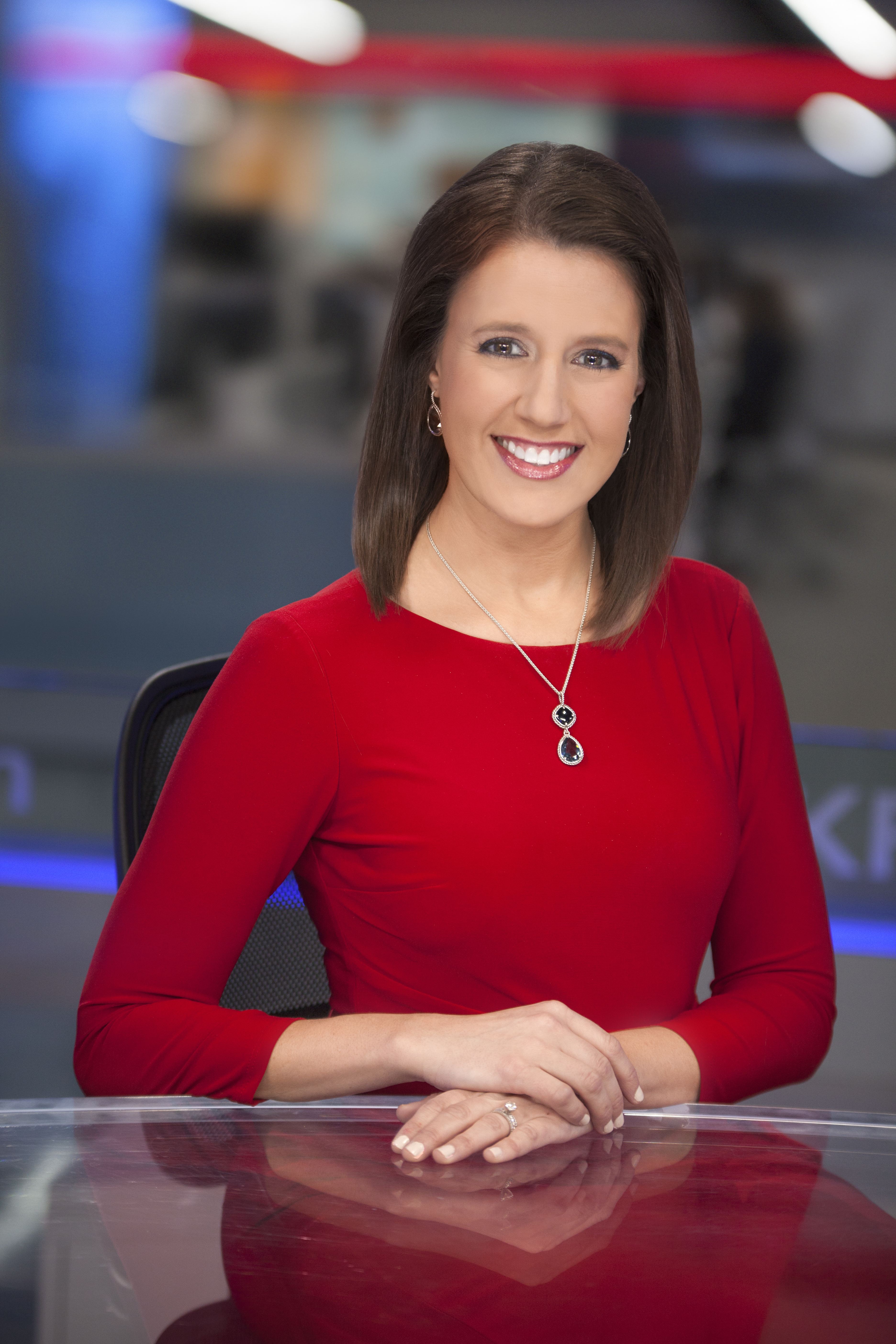 Next is Emily Sutton of KFOR Oklahoma City. She joined the station in 2009 and was their first female meteorologist. Within weeks, she was called into major duty as she covered the Christmas Eve Blizzard. We know she loves the weather, but she tells us, “if I weren't doing the weather, I'd probably be singing or performing somewhere, teaching science to kids and/or opening an ice cream shop.” Next is Emily Sutton of KFOR Oklahoma City. She joined the station in 2009 and was their first female meteorologist. Within weeks, she was called into major duty as she covered the Christmas Eve Blizzard. We know she loves the weather, but she tells us, “if I weren't doing the weather, I'd probably be singing or performing somewhere, teaching science to kids and/or opening an ice cream shop.”
Since being in Oklahoma City, she has covered all types of weather extremes and has even won awards for her storm chasing coverage. She is also the only female meteorologist in the state of Oklahoma with an NWA Seal. Sutton saw her first tornado while at the University of Missouri on the storm chase team in 2004. She graduated with honors and dual degrees in atmospheric science and media convergence journalism.
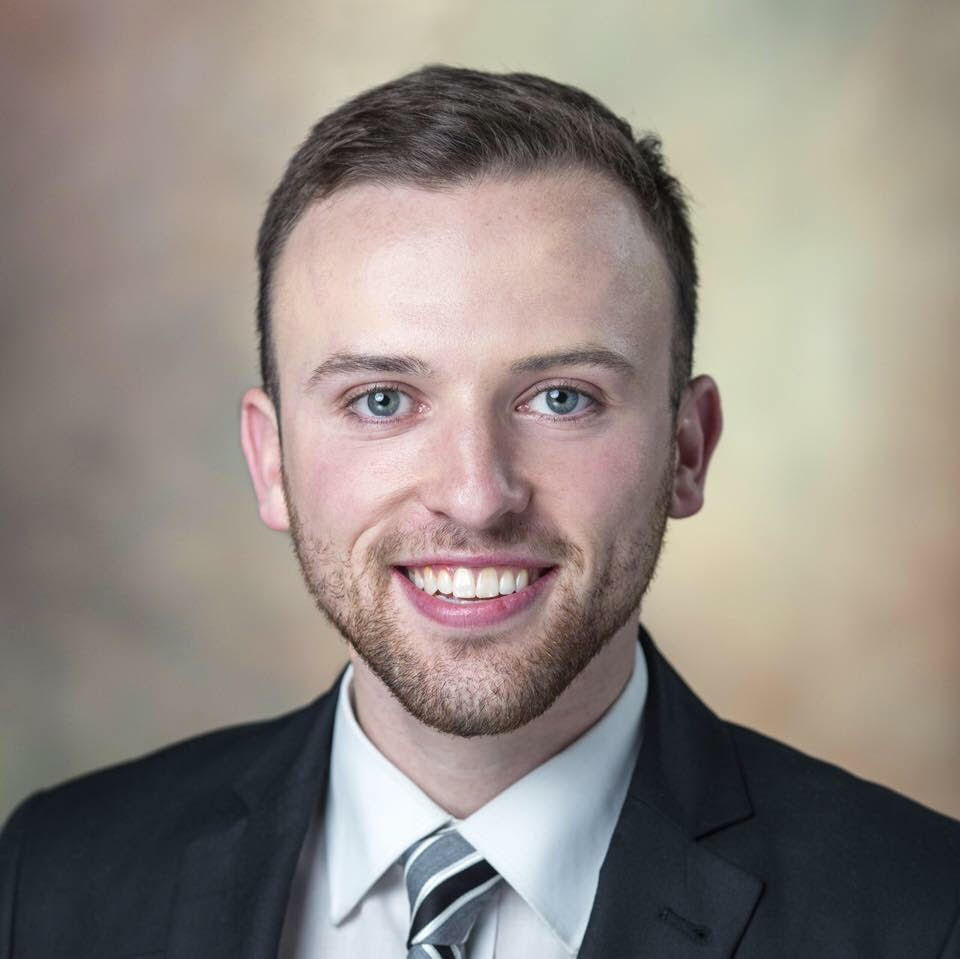 Finally, we have Cutter Martin at WTOC in Savannah, Georgia. He was born and raised on the Gulf Coast where he tracked hurricanes and enjoyed summer downpours. Finally, we have Cutter Martin at WTOC in Savannah, Georgia. He was born and raised on the Gulf Coast where he tracked hurricanes and enjoyed summer downpours.
Cutter has had a true passion for weather since he was a toddler. He graduated from Texas Tech University with a bachelor's degree in electronic media and communication with a minor in atmospheric sciences. While in college, he worked as a weekend forecaster and severe weather reporter/producer at KCBD-TV in Lubbock, Texas.
Upon graduation, Cutter seized an opportunity to get back to the coast, and of course the humidity! When not at work, he loves to eat, watch TV and run.
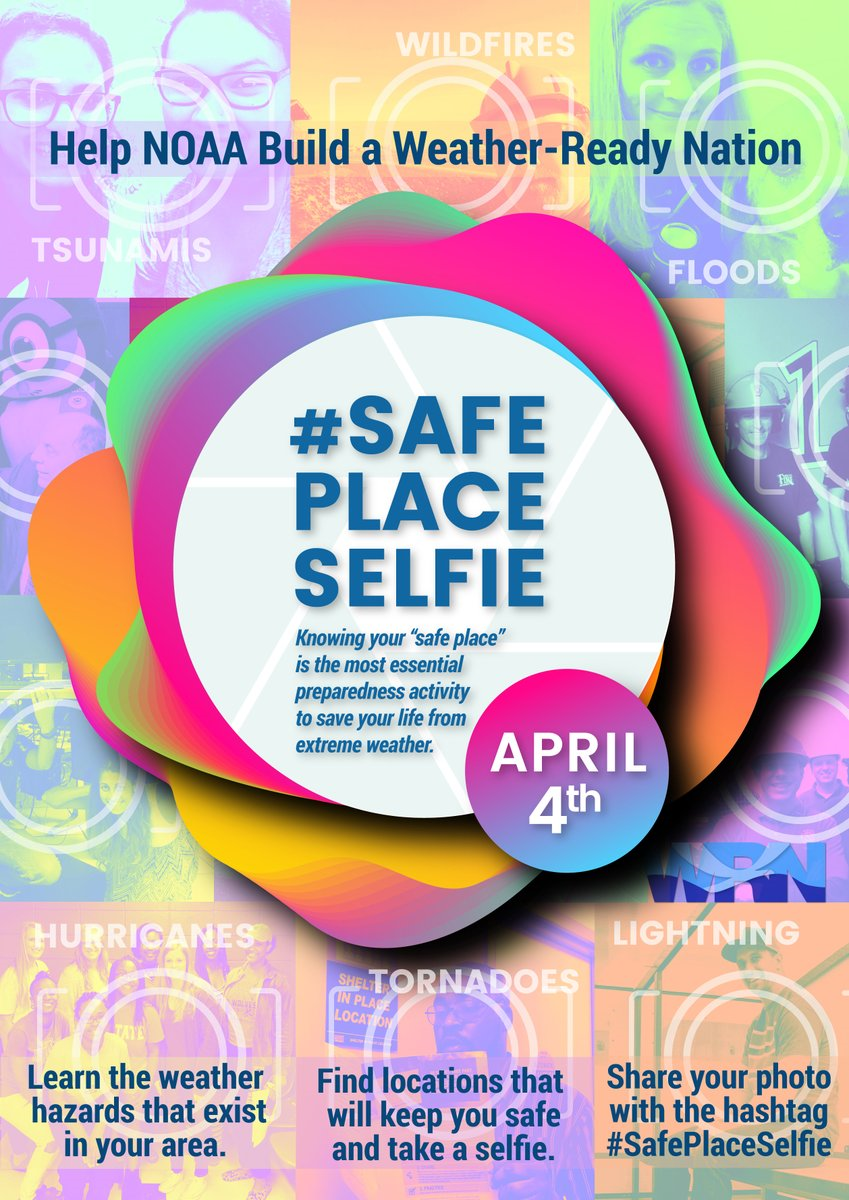
NLDAS Changes
 NWS Headquarters issued a public information statement asking for comments on their proposed upgrade to the North American Land Data Assimilation System (NLDAS) from version (v) 2.0 to v2.5. The NWS Environmental Modeling Center (EMC) will implement this upgrade during the summer of 2018 pending the outcome of public comments. NWS Headquarters issued a public information statement asking for comments on their proposed upgrade to the North American Land Data Assimilation System (NLDAS) from version (v) 2.0 to v2.5. The NWS Environmental Modeling Center (EMC) will implement this upgrade during the summer of 2018 pending the outcome of public comments.
This upgrade is being done to reduce errors and address known issues in the NLDAS products. The goals are to provide high-quality real-time drought monitor maps and datasets, and to provide the best-possible land-surface states for the initialization of operational numerical weather prediction models.
On February 1, 2018, EMC began disseminating experimental real-time NLDAS v2.5 products to users. Links to the products from both versions are in the statement issued on March 13. The technical details of v2.5 are in Section 2.3.1 of the NCEP LDAS upgrade white paper.
The NWS is seeking comments through April 9, 2018. All comments will be evaluated to determine whether to proceed with this upgrade. If approved, a 30-day notice will be given ahead of the implementation date. Information on how to submit comments is at the end of the public information statement.
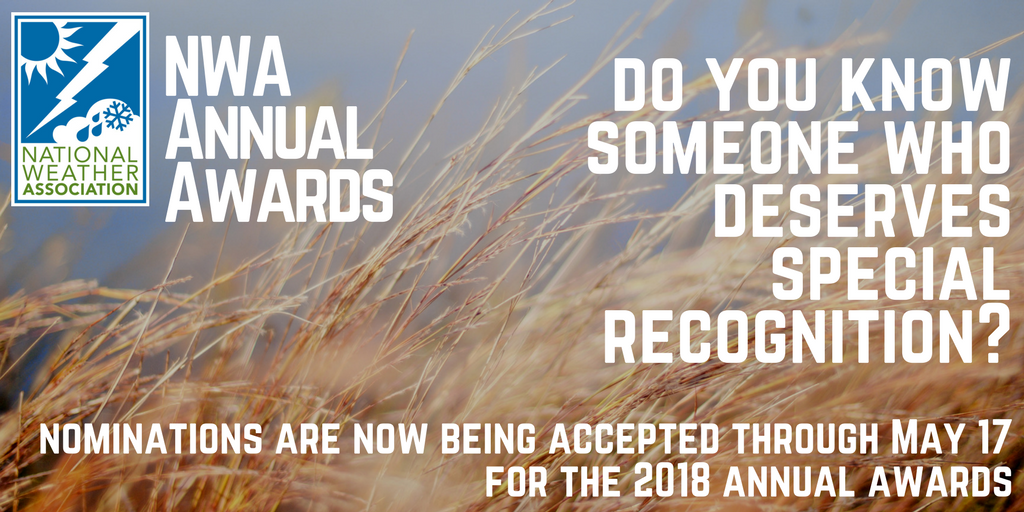
COMET Quarterly Announcement Spring 2018
David Russi, COMET Spanish Translator
Here are COMET’s newest publications on MetEd. Once again, we started the year with a bang. In the past three months we published nine new lessons, seven of them on satellite topics ranging from the more general on imagery interpretation to the more specific SatFC-J training. We also published eight new lessons in Spanish and three in French. The GOES-R Series Multilingual Training Resources page brings together some GOES-R training that is now available in Spanish and Portuguese, in addition to English.
New COMET Lessons
Satellite
SatFC-J: The VIIRS Day/Night Band
SatFC-J: The AMSR2 Microwave Imager
SatFC-J: The VIIRS Imager
SatFC-J: Orbits and Data Availability
GOES-R Series Multilingual Training Resources
Basic Satellite Imagery Interpretation
Rapid Scan Applications and Benefits
Other
Mesoscale Model Components of the National Blend of Models Version 3.0
Geodetic Control in Land Surveying: Active vs. Passive
New Spanish Lessons
SatFC-G: introducción al GLM
SatFC-G: Bandas IR, excepto las de vapor de agua
Teledetección por microondas: aplicación a las superficies terrestres y oceánicas, 2a ed.
Fundamentos de PNT: la física del modelo
Fundamentos de PNT: asimilación de datos
Fundamentos de PNT: precipitación y nubes
Señales de radar características de tiempo convectivo severo
Olas en aguas someras
New French Lessons
Vagues en eau peu profonde
Guide de référence des produits issus de SPE
Introduction au SPE
Currently, these materials are freely available to everyone, courtesy of our primary sponsors: NOAA's NWS, NESDIS and National Ocean Service programs, EUMETSAT, the Naval Meteorology and Oceanography Command, the Meteorological Service of Canada, Bureau of Meteorology, the U.S. Army Corps of Engineers, and the Department of the Interior Bureau of Reclamation.
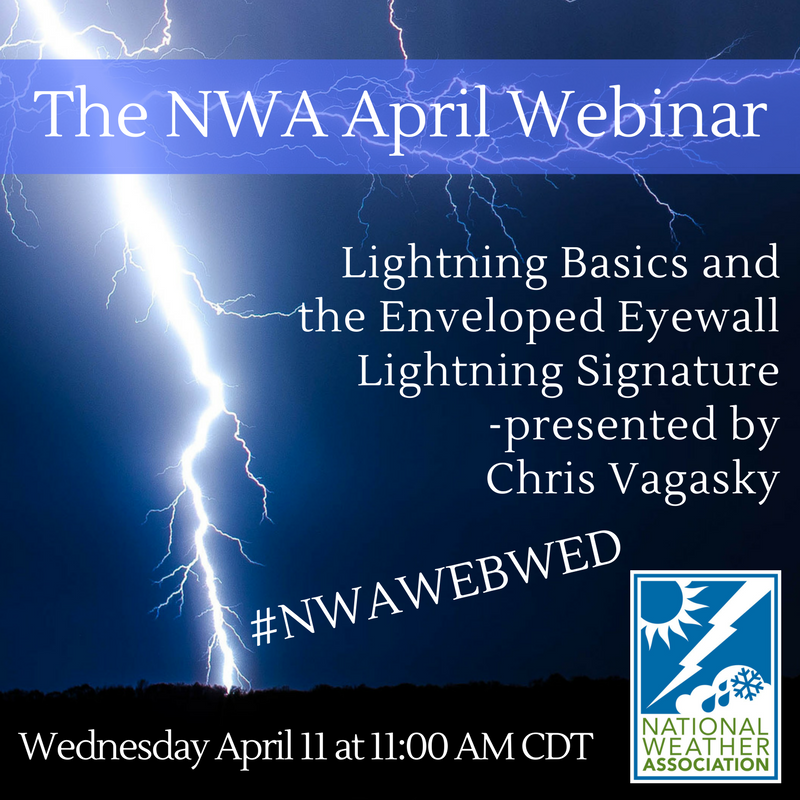
The High Plains AMS/NWA Chapter Minutes: February 23
(www.highplains-amsnwa.org)
Jeremy Martin, President - Wesley Hovorka, Secretary
The AMS/NWA High Plains Chapter held a meeting on Friday, February 23, at 11:30 a.m. with nine chapter members present. The meeting started with a treasury report of the current balances in the general and Jim Johnson Scholarship funds. Chapter dues are currently being collected, which will increase the amount in the funds. The next topic was the 20th High Plains Conference in Hastings, Nebraska, on August 7-9. There will be a severe weather workshop on the night of August 7, a full day of presentations on August 8, and a half day of presentations on August 9. A planning and logistics committee has been established for the conference. Keynote speaker invitations have been sent to Dr. Louis Uccellini (NWS Director), Jared Guyer (SPC), and Mark Robertson (University of Nebraska-Lincoln). Instead of having a fourth keynote speaker, the NWS Hastings office is thinking of having a panel consisting of Chris Strager (Central Region NWS Director), the Warning Coordination Meteorologist at NWS Hasting , a school superintendent, an emergency manager, and possibly a few other partners. Questions will focus on how the NWS can better serve partners during Decision Support Service events.
The last part of the meeting consisted of President Jeremy Martin informing the group that an email will be sent out asking what we should do with extra money in the general and Jim Johnson funds. Before the meeting adjourned, Brian Warren (Observation Program Leader, NWS Goodland) gave a presentation describing the winter weather seminars he gives to his observers and anyone interested. In these seminars, he reviews winter weather phenomena, demonstrates how to measure snow and ice, and outlines how to send weather reports to the NWS. At a recent talk, Brian and other NWS staff created mock observation stations for a hands-on approach. They used shaved ice to simulate snow for the participants to take snow observations and measure melted liquid equivalent. The participants also took turns reporting this information to the NWS via phone call, email, and social media.
The meeting ended at 12:30 p.m. after the presentation. The next High Plains Chapter meeting is expected to be in a couple of months.
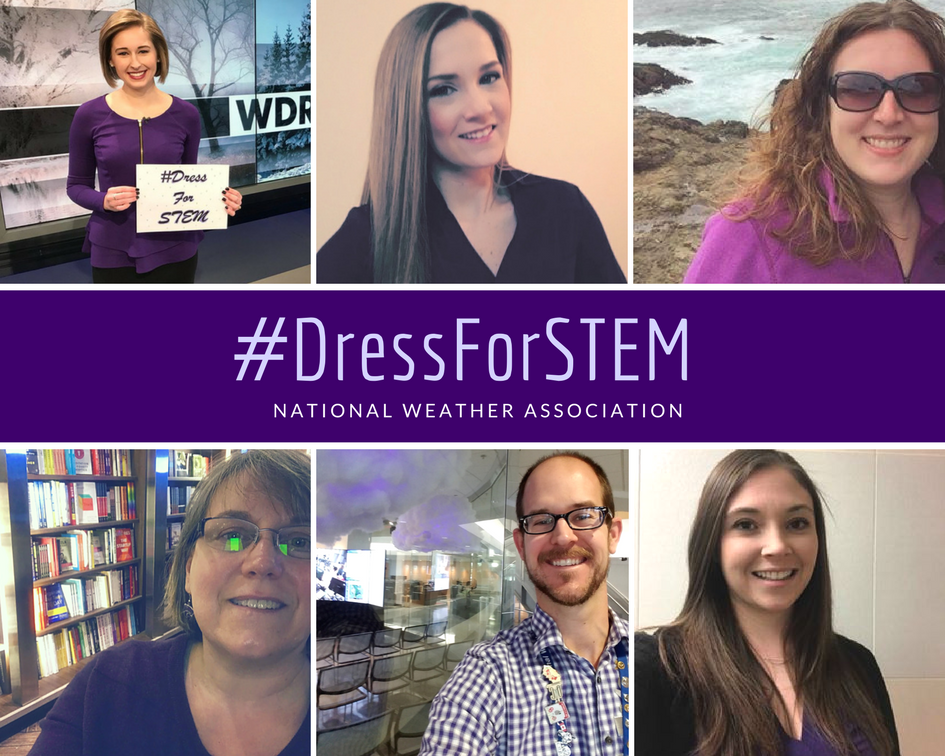 NWA participated in the #DressForSTEM in March NWA participated in the #DressForSTEM in March
Professional Development
You can find the current list of professional development opportunities on the NWA website. Click on the links in the list for more information about the events
NWA Sponsored Meetings and Events
**NWA 43rd Annual Meeting - August 25-30, 2018
FLASH Annual Conference - November 7-9, 2018
Other Meetings and Events
National Tropical Weather Conference - April 3-7, 2018
*Annual Meeting of the Missouri Academy of Science - April 27-28, 2018
*North American Hail Workshop - August 14-16, 2018
**AMS 99th Annual Meeting - January 6-10, 2019
*CEU Approved Credits: 1 CEU per full day, 0.5 CEU per half day
*To request approval for other events, please contact the NWA Recertification Chair, Shawn Cable
Note:
NWA Broadcast Workshop: 5 CEUs
**NWA or AMS Annual Meeting: 2 CEUs per full day, 1 CEU per half day
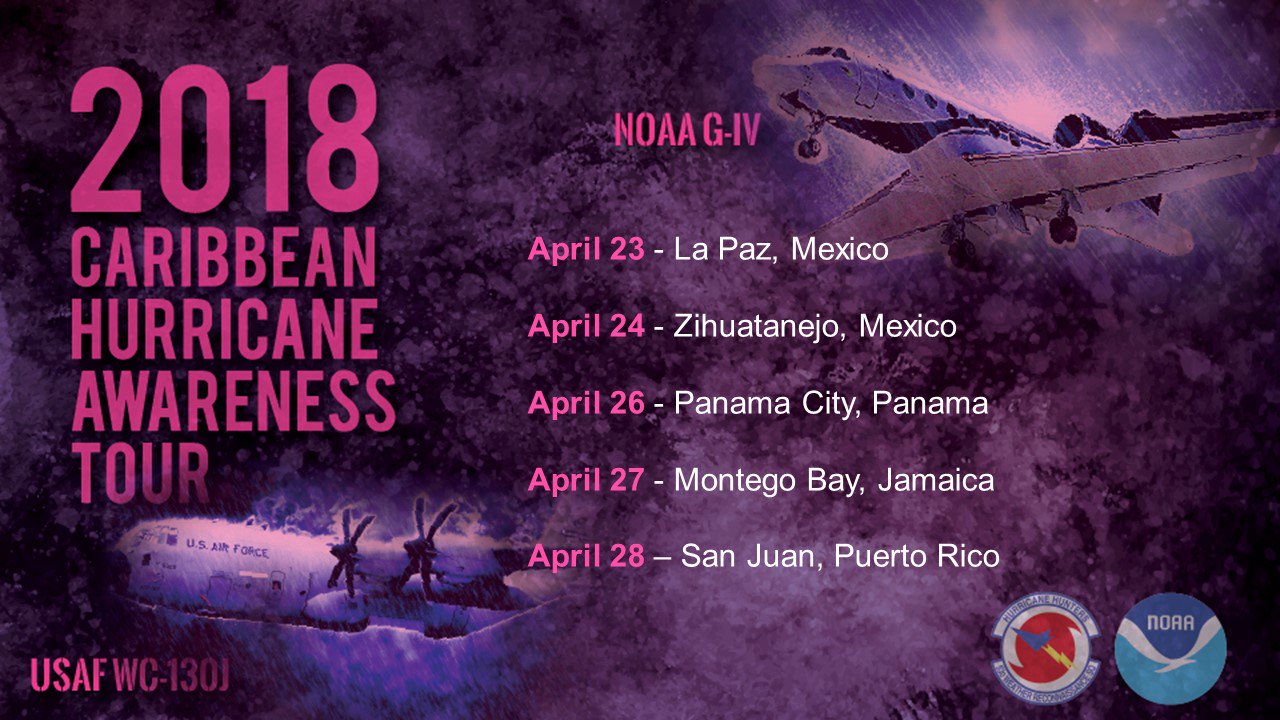
2018 NWA Annual Meeting Info
Watch for Registration and Hotel Room Block Opening up in April!
Location
43rd NWA Annual Meeting Venue and Hotel: Marriott St. Louis Grand, 800 Washington Ave., St. Louis, MO 63101
Meeting Theme
"Diversity in People, Models, and Methods"
In operational meteorology, it is generally accepted that ensembles of NWP models give superior forecasts over a single model. Models have biases and models make errors. No one model is always “right” but multiple models addressing the same scenario are often more correct together.
It’s the diversity of model “perspective” in resolution, time steps, data sets, and equations that gives value to ensembles.
Similarly, diversity of people-perspectives enriches individuals, creates a nimble group, and results in stronger product regardless of industry.
It’s diversity in the traditional sense of race, religion, gender, sexual preference, age, ability, custom, and language, but it’s also diversity in education, training, sector, and geographic region.
In our NWA mission of connecting operational meteorologists in pursuit of excellence in weather forecasting, communication and service, we’ll convene in Saint Louis to share diverse methodologies. From weather and data analysis and forecasting techniques, to fostering workplace environments where all meteorologists feel valued, we will account for the diversity of those who use the products we communicate, whether they are a community, company, agency, or individual.
As we embrace diversity within meteorology and focus on the diversity of the users, we promote excellence in operational meteorology to benefit society.
Important Dates
Oral and Poster Presenters Notified: mid-April 2018
Preliminary Agenda Posted On-line: early Summer 2018
2018 NWA Annual Meeting: 25-30 August 2018
Schedule of Events
NWAF WeatherReady Fest: Saturday, 25 August
Broadcast Meteorology Workshop: Sunday, 26 August
Student Session including Speed Mentoring: Sunday, 26 August
General Sessions: Monday-Thursday, 27-30 August
NWA Annual Awards Luncheon: Wednesday, 29 August
Airport Shuttle
NWA attendees will receive a special discount (10% off for a round trip reservation under $41!) if booked no later than August 23, 2018.

NWA Member Ken Graham Named New NHC Director
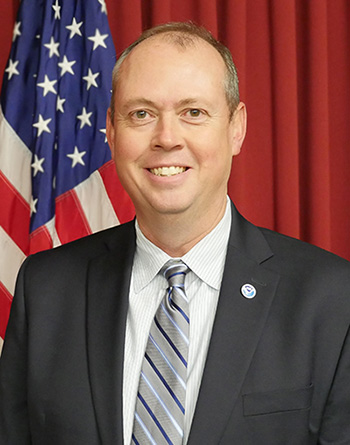 Ken Graham, NWA member since 1993, has been selected by NOAA to be the new director of the National Hurricane Center in Miami. He will assume this new role on April 1. Ken Graham, NWA member since 1993, has been selected by NOAA to be the new director of the National Hurricane Center in Miami. He will assume this new role on April 1.
Ken becomes the NHC director after serving as the meteorologist-in-charge of the NWS New Orleans/Baton Rouge office since 2008. Prior to that, he served as the systems operations division chief at NWS Southern Region headquarters in Fort Worth, Texas. He also served as the meteorological service chief at NWS headquarters in Silver Spring, Maryland, and was the meteorologist-in-charge at the local forecast offices in Birmingham, Alabama, and Corpus Christi, Texas.
Congratulations, Ken!
Welcome New Members
Please welcome our newest NWA members!
Connor Belak
Dillon Blount
Jonathon Bongard
Ashley Brewer
Sandra Caggianelli
Robert Eschbaugh
Sara Gallman
Robert MacDonald
Nathan Polderman
Harrison Rademacher
Ariel Rodriguez Meulenert
Sam Sangster
Jorge Torres
Member Connect
It used to be called the Member Portal. You voted, and our shiny new membership system is now called Member Connect.
Thank you to all who voted.
NWA Newsletter Survey
Please take this survey and let us know how you feel about this newest newsletter format.
|
 From winter storms to severe storms and hurricanes, we in the weather enterprise track tempests traversing the landscape. The prospect of a powerful low pressure system brings high pressure to our lives. That pressure can create anxiety and stress, with stress being both mental and physical.
From winter storms to severe storms and hurricanes, we in the weather enterprise track tempests traversing the landscape. The prospect of a powerful low pressure system brings high pressure to our lives. That pressure can create anxiety and stress, with stress being both mental and physical. 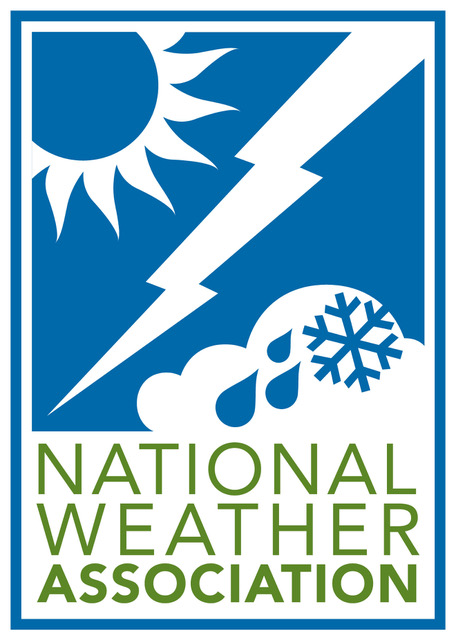



 First is John Kubis from WWNY Watertown, New York. John first started reporting weather for the Air Force. In 2009, he began doing the weather for WWNY on the weekends. He has since been promoted to evenings as Chief Weathercaster. John said he’s thrilled to receive the NWA Seal. He told us he used to chase tornadoes at Tinker Air Force Base in Oklahoma “before there was internet or RadarScope.”
First is John Kubis from WWNY Watertown, New York. John first started reporting weather for the Air Force. In 2009, he began doing the weather for WWNY on the weekends. He has since been promoted to evenings as Chief Weathercaster. John said he’s thrilled to receive the NWA Seal. He told us he used to chase tornadoes at Tinker Air Force Base in Oklahoma “before there was internet or RadarScope.”  Next is Emily Sutton of KFOR Oklahoma City. She joined the station in 2009 and was their first female meteorologist. Within weeks, she was called into major duty as she covered the Christmas Eve Blizzard. We know she loves the weather, but she tells us, “if I weren't doing the weather, I'd probably be singing or performing somewhere, teaching science to kids and/or opening an ice cream shop.”
Next is Emily Sutton of KFOR Oklahoma City. She joined the station in 2009 and was their first female meteorologist. Within weeks, she was called into major duty as she covered the Christmas Eve Blizzard. We know she loves the weather, but she tells us, “if I weren't doing the weather, I'd probably be singing or performing somewhere, teaching science to kids and/or opening an ice cream shop.”  Finally, we have Cutter Martin at WTOC in Savannah, Georgia. He was born and raised on the Gulf Coast where he tracked hurricanes and enjoyed summer downpours.
Finally, we have Cutter Martin at WTOC in Savannah, Georgia. He was born and raised on the Gulf Coast where he tracked hurricanes and enjoyed summer downpours. 
 NWS Headquarters issued a
NWS Headquarters issued a 




 Ken Graham, NWA member since 1993, has been selected by NOAA to be the new director of the National Hurricane Center in Miami. He will assume this new role on April 1.
Ken Graham, NWA member since 1993, has been selected by NOAA to be the new director of the National Hurricane Center in Miami. He will assume this new role on April 1.